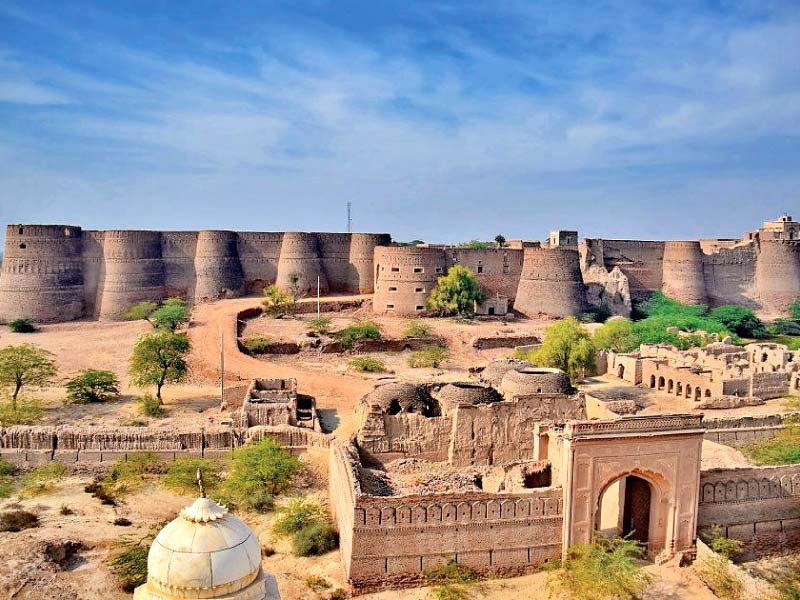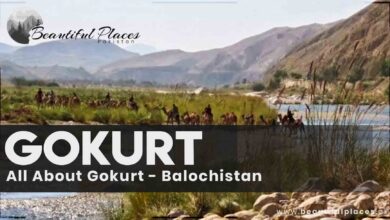Cholistan Desert
(Gateway of Adventure)
The area of Cholistan is ten thousand three hundred and ninety-nine square miles (10,399 square miles). It stretches 483 km in length from northeast to southwest and 64 to 290 km in width.District Bahawalnagar, Bahawalpur, and Rahim Yar Khan are included in this area.
This desert area extends to the agricultural area of Sindh and to the areas of Bikaner and Jaisalmer towards India.This area is also called “Rohi”. The climate is too hot and sometimes the temperature goes beyond 54. Some sand dunes of Sand are higher than 500 feet. Mostly the people are nomads due to a lack of rain.Camels are used as transportation means.
About 1000 years ago, it was a green fertile land. River Hakra used to irrigate this area. It is known as Ghagra and Saraswati in India.History revealed that cities and towns were settled on the sides of the river. Settlements deserted when the river dried up and they moved to the suburbs. Cholistan has signs of 400 ancient settlements.

The archaeological experts match this desert area to the archeological sites of Harappa. Many forts are built there.
They include the Derawar fort (50 km from Bahawalpur), Islam Garh Fort (150 km from Derawar fort near Indian Border), Mehar Garh fort (21 km from Abbas city), Jam Garh Fort ( 9 km from Mehar Garh), Marot fort (11km from Jam Garh), Moj Garh Fort ( 32 km from Marot Fort), Khan Garh Fort (70 km from Derawar Fort), Khair Garh Fort ( 70 km from Derawar fort), Nawa Kot Fort ( 45 km from Derawar fort), Bajnot Fort ( 45 km from Nawa Kot ) and Oliyara fort.
Key info about Cholistan Desert
| Attribute | Information |
|---|---|
| Location | Southern Punjab, Pakistan |
| Area | Approximately 16,000 square kilometers |
| Climate | Arid desert climate with scorching summers and cold winters |
| Landscape | Vast stretches of sand dunes, flat plains, and sparse vegetation |
| Tribes | Inhabited by the Cholistanis, mainly the Samaa, Khosa, and others |
| Economy | Primarily dependent on livestock farming, including camels and cattle |
| Tourism | Popular for its annual Cholistan Desert Rally, showcasing off-road racing and cultural festivities |
| Wildlife | Home to various species, including the Chinkara gazelle and desert fox |
| Cultural Heritage | Rich in traditional customs, arts, and crafts, particularly in camel-rearing communities |
| Historical Sites | Contains ancient ruins and forts, such as Derawar Fort |
| Challenges | Faces water scarcity and desertification issues, affecting livelihoods |
| Biodiversity | Despite arid conditions, the desert supports a variety of plant and animal species adapted to the harsh environment |
| Notable Features | The Derawar Fort, a massive and iconic desert fortress, is a prominent landmark |
| Accessibility | Accessible by road, and the annual rally attracts visitors from across the country |
Famous Fort of Cholistan Desert
The great masterpiece of ancient civilization in the desert
It is 47 km from Ahmad Pur Sharqiyah. No one has known about its exact history. But is assumed that this fort was built in the middle of the civilization two and a half thousand years before Christ.
The walls and towers of this square-shaped fort can be seen from Cholistan which is miles away. It is said that this fort was built by Hindu Rajpoot Roy Jajja Bhatti Jaisalmer.
In 1733, Nawab Muhammad Kha Bahawal led the foundation of Bahawalpur state and declared Derawar its capital. He renovated this fort. Bricks were imported from Uch Sharif which is 60 km away.
The process of shifting these bricks was very interesting. They were transported through a man-made chain of hands from Uch to Derawar.
This grand fort has 40 towers with a strong boundary. If you enter through the only entrance on the east side, the tunnel-like path goes up.
This fort is at a height of 60 feet from ground level. Intellectuals, orators, and calligraphers lived in the first building next to the main entrance. The fort has seven floors.

In addition to the upper floor, the other six floors are underground, with an automated system installed to reach them. Cold Basements were specially built to withstand the heat of the scorching weather.
It also has magnificent tombs of the royal family, a podium for celebrations, two cannons, a special part of the Harappa era, two wells, and a grand mosque. This mosque is constructed with white marble and it was completed in 1848 within a duration of six years.
This fort is in control of the Nawab Family. A permission letter must be obtained from Dera Nawab Sahib city for visiting this fort.
Jamiya Mosque Derawar Fort
When Muslim rulers conquered the ancient forts, they built mosques there. They constructed forts and built mosques in them before the residential area.
Mosques were built near the old forts due to a lack of space inside the forts. It is assumed that there was a small mosque outside the Derawar fort in the first Hijri.
Ameer Muhammad Bahawal Khan built a spectacular mosque in 1825 during his regime. Marble stone is used in its construction. It resembles Delhi Shahi Mosque.

The mind is amazed that such a quantity of marble in such a desolate desert must have come from so many places. This mosque still exists today in excellent condition but unfortunately, they are not worshipers.
Cholistan Desert Safari and Jeep Rally
(Passport to Adventure)
Stretching up to 25000 square kilometers, it is the largest desert in Pakistan. For the awareness of desert Cholistan culture, rituals, and traditions camel safari and jeep safari are two options.
Derawar Fort can be a great starting point for a tour of Cholistan. You can avail experienced guide there. They will arrange a camel or a jeep. The best season for the desert safari is November to march.
Arrange for the camping stuff, joggers, blankets for cold nights, jackets, sleeping bags, mineral water, and fast food. Travel to villages and towns to become familiar with the culture.

Can you imagine the wonderful sight during the camp safari – the moonlit nights with the shadows of the twinkling stars, the cool breeze in the cold weather, and you are sitting around the fire and sipping tea wrapped in a blanket, camel dancing around, and with the sounds of regional melodies in the air?
The annual jeep rally which is organized every year in the march is Pakistan’s largest motorsports festival. The tourist department of TDCP can assist with Jeep Rally, Desert Safari, and camel safari.
Exploring the Mystique of Cholistan Desert
Geography and Landscape
Cholistan Desert is part of the larger Thar Desert and extends into southeastern Pakistan, sharing borders with India. The landscape is characterized by rolling sand dunes, scattered vegetation, and occasional patches of shrubs. The Sutlej River flows along its northern boundary, providing a lifeline to the region by supporting some vegetation and sustaining the local population.
Ancient History and Archaeological Sites
Cholistan has a history dating back thousands of years, and evidence of ancient civilizations has been discovered in the region. The archaeological site of Derawar Fort stands as a testament to the rich history of Cholistan. Believed to be built in the 9th century by Rai Jajja Bhatti, the fort has served as a strategic military outpost and a symbol of power for various rulers over the centuries.
Culture and Traditions
The people of Cholistan, primarily the nomadic tribes, have a distinct and vibrant culture. The most prominent among them are the Saraiki-speaking Saraiki people and the camel-raising nomads known as the Rohi. These communities have maintained a deep connection with their traditions, visible in their colorful attire, traditional music, and folk dances.
Economy and Livelihood
Cholistan’s economy is primarily agrarian and revolves around livestock farming, especially camel breeding. The Cholistan Desert is renowned for its Marrecha breed of camels, known for their endurance and strength. The camel plays a crucial role in the lives of the locals, serving as a mode of transportation and a source of livelihood. The annual Cholistan Desert Jeep Rally, held near Derawar Fort, is a testament to the importance of these versatile animals.
Wildlife and Biodiversity
While the harsh conditions make it challenging for many forms of life to thrive, Cholistan is not devoid of biodiversity. The desert is home to various species of reptiles, small mammals, and numerous bird species. The Chinkara gazelle, desert cat, and various species of lizards are among the wildlife that has adapted to the arid environment.
Tourism Potential
In recent years, Cholistan has gained attention as a potential tourist destination. The stark beauty of the desert, coupled with its historical sites and unique culture, makes it an intriguing place for adventure seekers and history enthusiasts alike. Visitors can explore the mesmerizing landscapes, visit ancient forts, and experience the warm hospitality of the locals.
FAQs
What is Cholistan Desert known for?
Cholistan Desert is renowned for its vast expanse of arid land, ancient history, and vibrant cultural heritage. It is a part of the Thar Desert and is located in the southern region of Punjab, Pakistan.
What are the major attractions in Cholistan Desert?
Key attractions in Cholistan include Derawar Fort, an ancient fort with a rich history, and the annual Cholistan Desert Jeep Rally, a thrilling off-road race near Derawar Fort. The desert’s unique landscapes, traditional villages, and the nomadic way of life are also notable attractions.
Which tribes inhabit Cholistan Desert?
The Saraiki people, primarily speaking the Saraiki language, and the camel-raising nomads known as the Rohi are the main tribes inhabiting Cholistan. These communities contribute significantly to the cultural richness of the region.
What is the significance of Derawar Fort?
Derawar Fort, believed to be built in the 9th century, holds historical significance as a military outpost and a symbol of power for various rulers over the centuries. Its impressive architecture and panoramic views make it a major attraction in Cholistan.
How important are camels in Cholistan’s economy?
Camels play a crucial role in the economy of Cholistan. The Marrecha breed of camels, known for their endurance, is raised by the locals. Camels serve as a mode of transportation, a source of livelihood, and are celebrated in events like the Cholistan Desert Jeep Rally.
What is the Cholistan Desert Jeep Rally?
The Cholistan Desert Jeep Rally is an annual off-road motorsport event held near Derawar Fort. It attracts participants and spectators from around the world and showcases the challenging terrains of the desert, providing an adrenaline-pumping experience.
Is Cholistan open for tourism?
Yes, Cholistan is open for tourism, and its unique blend of history, culture, and landscapes is attracting an increasing number of visitors. However, sustainable tourism practices are encouraged to preserve the delicate ecosystem of the desert.
What is the wildlife in Cholistan Desert?
Despite its arid conditions, Cholistan is home to various forms of wildlife. This includes the Chinkara gazelle, desert cat, and several species of lizards. The adaptability of these species to the harsh environment is a testament to the desert’s biodiversity.
How do the people of Cholistan maintain their traditional way of life?
The people of Cholistan, particularly the nomadic tribes like the Rohi, maintain their traditional way of life through practices such as camel breeding, traditional music, and folk dances. Their colorful attire reflects the cultural richness that has been preserved for generations.
What measures are in place to preserve Cholistan’s ecosystem?
Efforts are underway to promote sustainable tourism in Cholistan to ensure the preservation of its delicate ecosystem. Balancing the influx of visitors with conservation initiatives is crucial to maintaining the environmental integrity of this unique desert region.
Wind Up Lines
The land of Province Punjab is enriched with historical landmarks, traces of ancient civilizations, and beautiful tourist spots. The Cholistan Desert, and Derawar Fort are assets of Pakistan.



